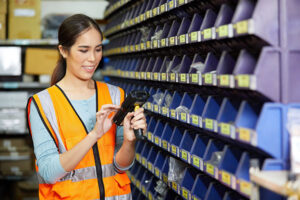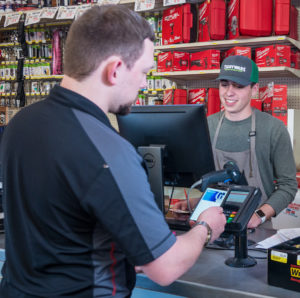Retail Trends: New Tools, Familiar Objectives
French writer Jean-Baptiste Alphonse Karr put those words together in 1849 to express, maybe sarcastically, that turbulent times don’t actually change reality on its deepest levels. For independent retail businesses, the past few years have been the most turbulent of recent times. Yet, looking at what retail trends are expected for in 2023, they aren’t a lot different than what they have been over the past several years.
For the upcoming 12 months, retail pundits feel that stores should:
Automate processes like ordering, inventory control, analytics, and more to increase efficiency and cope with labor shortages.
Widen supply chains to avoid out-of-stock items, back orders, and unhappy shoppers.
Improve customer service with smoother checkout and delivery.
Connect with consumers through a variety of channels.
Personalize shopping experiences.
 Automate processes
Automate processes
Forrester’s Predictions 2023: Retail says “Automation will be the savior for continued retail labor shortages. Ripple effects from the Great Resignation will force retailers and brands to invest more heavily — and more strategically — in automation in 2023.”
While technologies such as artificial intelligence (AI), virtual reality (VR), and machine learning are popular and have become modern industry buzzwords, business technology has provided automation that helps businesses utilize transaction data combined with advanced algorithms to forecast sales and, with that, staffing needs for many years.
Modern point-of-sale systems combined with inventory management and workforce management specialty software simplify ordering, inventory, and staff scheduling to save businesses time and effort.
“What we offer are tools that help retail businesses simplify their operations through automation,” says Dan Nesmith, founder and president of Paladin Data Corporation, a leader in retail management technology. “It lets them make more money through precise inventory management and automating time-consuming retail operations. Our software features and integrations simplify online and in-store purchasing, inventory management and delivery.”
Ross Martin owns Caledonia Village Ace Hardware in Caledonia, Michigan. He uses Paladin Data Corporation’s Suggested Order™ to simplify his orders from Ace. It uses historical sales data and proprietary algorithms to forecast inventory needs. He says it has allowed his store to keep an in-stock percentage of 97% to 98%, which Ross says helped him earn Ace Pinnacle status as a top-performing store two years in a row.
“Our store uses Suggested Ordering 100%. Ace considers 95% really good and we’re always above that,” he says.
His retail management system features two other tools that save stores time and effort and reduce supply chain challenges.
Remote Stock Check allows many store owners to see what products are in stock at their regional warehouses, so they can place more accurate orders. This increases their fulfillment rates and reduces out-of-stock surprises.
Order Analyst™ automatically searches a store’s EDI supplier catalogs for the lowest price items in an order. Then it can split purchase orders based on those costs. This saves hours in price shopping and manual preparation of purchase orders.
Widen supply chains
The pandemic served as a wake-up call, or at least a painful reminder, about how dependent global retail is on the Chinese manufacturing of most consumer goods. In response, retail businesses around the world have expanded the number of suppliers they now use to keep their shelves stocked.
Managing various suppliers can be daunting for small businesses, but stores that operate on systems that can handle multiple EDI (electronic data interchange) suppliers can smooth the process. Add the ability of a retail management system to provide suggested orders, and stores can more efficiently handle ordering and receiving products.
 Improve customer service
Improve customer service
Impeccable customer service is the goal of every business and the pandemic added new emphasis to it when shoppers sought to avoid checkout lines and contact with almost everything. It led to the rise of convenience trends such as buy online, pickup in-store (BOPIS), buy online, return in-store (BORIS), curbside pickup, and more.
Contactless terminals use near-field technology (NFT) to accept a variety of payment types, allowing customers to pay for purchases with the wave of a credit or debit card or a smartphone with a payment app.
These programs are impossible to use without cohesive point-of-sale and retail management systems. They also require comprehensive mobile technology that allows remote sales and delivery management. These features increase efficiency, accuracy, and improve customer service.

Connect with consumers
Adobe’s A Guide to Retail Customer Experience trends in 2023 says the world’s biggest brands are investing “a whopping $700 million in customer experience.” Much of that investment is to connect with shoppers via a variety of channels – also known as omnichannel.
Omnichannel has been growing steadily thanks to the rise of e-commerce but has been one of the hottest trends since the pandemic closed so many retail stores in 2020. According to Fit Small Business, connecting with shoppers using three or more channels can increase orders by nearly five times. It also says omnichannel shoppers spend 10% more online and 4% more in-store than single-channel shoppers.
The upshot here is that if stores aren’t reaching out to shoppers through web stores, social media, and SMS, they’re missing sales. It’s not just for big-box and online retailers, either.
Buck Electric Ace Hardware, an independent store in Ocean Shores, Washington, began a digital campaign with Pointy by Google, which allows the store to promote its products online without investing in an extensive and expensive web store. It allowed the store to increase sales by reaching shoppers who might not have normally seen its traditional advertising.
“It seems like everybody today just clicks on Amazon.com to shop and there are a lot of items we have that are the same price. This gives us the chance to get that sale first,” explains Jody Cadle, Buck Electric’s bookkeeper and marketer.
Personalize the shopping experience
Personalizing the shopping experience for customers was a huge trend before the pandemic. However, since many of those efforts were very hands-on experiences in the form of special in-store shopping events, workshops, new product releases, and such, COVID-19 was a huge buzz kill.
Shoppers and retail have adapted, though, and much of the personalization has moved online. Consumers today favor stores that know them well enough to offer product suggestions, apparel sizing, cross-selling items, and more. A SmartHQ survey shows nearly three-quarters of shoppers say they only respond to marketing messages that are exclusively crafted to their choices.
As shoppers have become more at ease with returning to live events and in-store shopping, experiential retail has returned. A Forrester study shows that:
32% of consumers said they’re likely to engage with in-store experiential events.
47% were more likely to buy from a brand with a local presence.
81% of GenZ consumers prefer to shop in stores to discover new products.
Upshot
Retail trends for 2023 may seem like the latest new car with all the electronic gadgets and toys, but aside from the new tools gathering information and helping dispense customer service, their objectives haven’t changed a lot over the years.
brian bullock
Author


